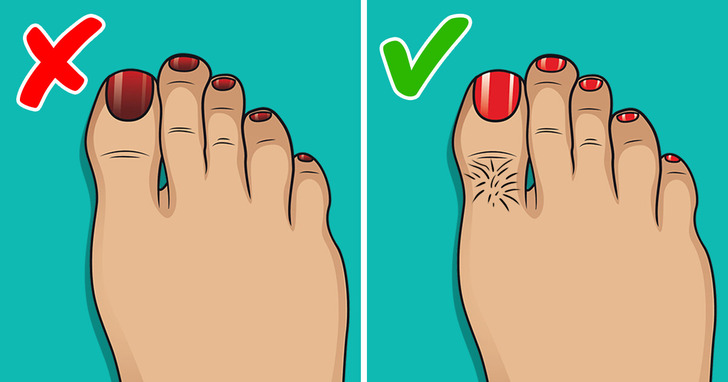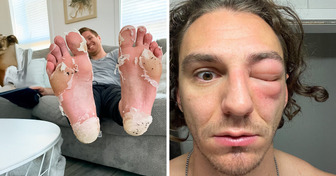5 Alarming Red Flags That Scream Colon Cancer Might Be Present


Your feet are more than just a means of getting from point A to point B—they can offer vital clues about your overall health. Many foot symptoms, such as pain, swelling, or discoloration, might signal underlying conditions that require medical attention. By staying alert to these changes, you can potentially catch health issues early and seek timely treatment.
CONTENT IS PROVIDED FOR INFORMATIONAL PURPOSES ONLY AND IS NOT INTENDED AS A SUBSTITUTE OF MEDICAL ADVICE. SEEK GUIDANCE OF YOUR DOCTOR REGARDING YOUR HEALTH AND MEDICAL CONDITIONS.
Dry, peeling skin on your feet may not just indicate neglect, but could point to a fungal infection, such as athlete’s foot. If left untreated, it may progress to blisters that could burst, spreading the infection. If you notice symptoms of athlete’s foot, it's vital to consult a doctor for proper treatment to stop the infection from spreading and alleviate discomfort.
Foot cramps can be incredibly painful, caused by muscles tightening unexpectedly. This usually happens when you’re working out or if you’re dehydrated. But if you’re getting cramps often, it could be because you’re low on calcium, potassium, or magnesium. To help, try eating more veggies, drinking water with minerals, and make sure to stretch your feet before bed.
Pregnant women are also prone to experiencing these cramps due to hormonal changes.

If you've noticed hair loss on your feet, it could indicate poor blood circulation. When blood flow is restricted, the body vital organs are affected, limiting circulation to extremities like your toes. Additionally, hair loss on the feet may also be a sign of diabetes, as it often causes blood circulation problems. Conversely, healthy blood flow is reflected in the presence of toe hair, promoting wound healing and sensation. So, having some toe hair is a good thing.
If you notice any changes, like new hair growth, moles, or blisters, it’s a good idea to mention it to your doctor.
Dry, cracked skin around your heel or foot could be a sign of thyroid problems. The thyroid is responsible for regulating many bodily functions, and dry, cracked heels could indicate an imbalance. Other symptoms, such as weight gain or changes in vision should prompt a visit to your doctor. Cracked heels are often caused by calluses—thickened, dry skin on the edge of the heel. When walking, the fat pad under your heel expands, leading to cracks. Factors like standing for long periods, wearing poorly fitting shoes, or using harsh soaps can worsen cracked heels.
Of course, dry skin can also just happen because of weather changes. But if you're also experiencing weight gain or vision issues along with dry feet, it's best to see a doctor.
Cracked heels usually start with dry, thick skin around the edge of your heel, known as calluses. When you walk, the fat under your heel expands, which can cause these calluses to crack.
Things that can make cracked heels worse include:
If you don’t moisturize your feet often, they might dry out even more quickly.
If your toenails become thickened, discolored, or yellow, it may indicate a fungal infection. Fungal infections thrive in warm, moist environments and can distort nail growth, affecting the nail bed. While topical treatments are available, these infections can recur, especially if there's an underlying health condition.
Yes, foot problems can be a sign of heart disease. Issues like foot pain, swelling, or burning sensations can be linked to poor circulation, which is often caused by cardiovascular conditions such as peripheral arterial disease or high blood pressure.
These conditions reduce blood flow to the feet, leading to discomfort, numbness, and even non-healing ulcers. Additionally, symptoms like burning, swelling, or abnormal coloring in the feet can suggest underlying heart, kidney, or circulatory problems. It’s essential to consult a podiatrist if you experience these signs, as they could be early indicators of heart disease or related health issues.
Diabetes can affect your feet in a few ways. High blood sugar can cause nerve damage, leading to tingling, pain, or even loss of feeling in your feet. Without feeling, you may not notice small injuries like blisters or cuts, which can get infected. Diabetes can also reduce blood flow to your feet, making it hard for infections or wounds to heal. This can lead to serious problems, like gangrene.
To keep your feet healthy, check them every day, wash and dry them well, wear proper shoes, and visit a podiatrist regularly. Managing your blood sugar is also key to preventing foot issues. People with diabetes need to be extra careful with their feet. Diabetes affects around 1 in 10 Americans, and most people with it—about 60% to 70%—end up having nerve problems.
Numbness in your feet can be caused by several conditions, like diabetes, sciatica, or nerve damage. When nerves are damaged or compressed, you may lose feeling in your foot, which can affect your balance. You might also feel tingling, pins-and-needles, or weakness.
If the numbness comes on suddenly with other symptoms like confusion, dizziness, or difficulty breathing, seek medical help right away. If numbness makes you trip or worsens over time, make an appointment with your doctor. Be sure to ask them for advice and treatment options.
Experiencing ongoing foot pain that intensifies throughout the day could be a sign of arthritis. Progressive foot pain might also result from stress injuries or fractures. It's essential to consult a healthcare professional to determine the cause and receive appropriate treatment.
Monitoring changes in your feet can provide valuable insights into your overall health. If you notice persistent or concerning symptoms, it's advisable to seek medical attention promptly.
Cold feet are common and can be caused by various factors. It may be linked to your circulation or an inherited trait. When your body gets cold, blood vessels in your hands and feet constrict, reducing blood flow to keep internal organs warm. People with less body fat may feel colder.
Raynaud’s syndrome causes blood vessels to overreact to the cold, turning your feet blue, white, and red. Poor circulation from conditions like atherosclerosis can also cause cold feet, making them appear blue or white, and causing pain in your legs when walking. Nerve damage (neuropathy) may make your feet feel cold, even if they’re not. If you’re concerned, consult your doctor to check for circulation or nerve issues.
Maintaining a healthy weight is important because weight gain is often connected to foot pain. In an APMA survey, 74% of people who were overweight and 81% of those with excess weight reported having foot problems.
Always listen to your body. Sometimes it can overtly signal problems to us. Here are 7 ways your body secretly tells you that you are stressed.











